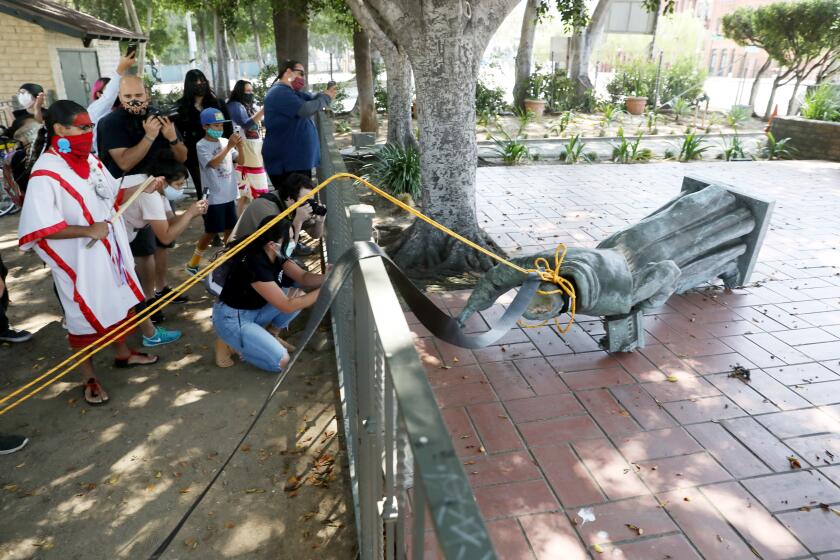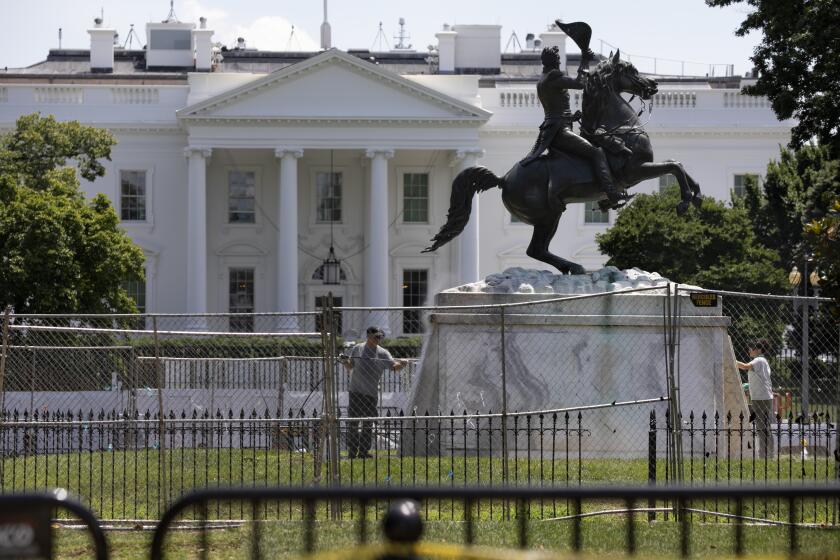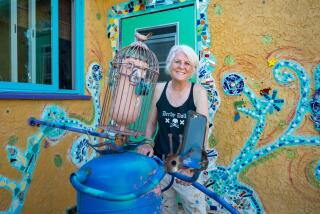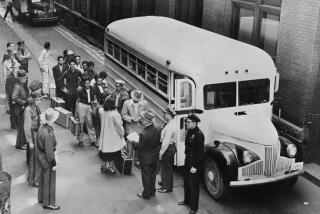Junípero Serra statues to come down in Ventura, city leaders decide

- Share via
Nearly 100 speakers took turns over three hours extolling the virtues or excoriating the legacy of 18th century Roman Catholic Saint Junípero Serra in a Ventura City Council virtual meeting Wednesday evening.
In the end, it was decided a bronze statue of the controversial California missionary — who has come under recent and intense scrutiny statewide — would be hauled away from in front of Ventura City Hall. A similarly sized wooden replica, located inside City Hall, will also be removed.
The 6-0 unanimous vote, which included one abstention from Mayor Matt LaVere, took place on the feast day of the patron saint of Ventura’s Mission Basilica San Buenaventura.
When the statues will be removed has yet to be determined, but the resolution declared “the intent” to relocate both to the mission.
“We have received thousands of emails, hundreds of messages, and so I think this is truly an example for other cities ... of how the public process can involve many voices,” Ventura Deputy Mayor Sofia Rubalcava said.
Junipero Serra was declared a saint in 2015. But his role in California’s colonization via the mission system makes him a target for statue toppling.
Before the council agreed to move the statues, it first voted, 6-0, to declare that the bronze monument — a replica built in 1989 — was not a historic monument, which made its removal easier. The council also voted, 6-0, to adopt a California Environmental Quality Act exemption because removing the statue will not significantly impact the environment.
“We need to preserve it; we need to make sure that this monument remains, but that it does not remain on city land,” Councilman Erik Nasarenko said of the bronze replica. “It needs to be housed somewhere that is more appropriate than a city municipal park, which is where it is right now.”
Despite the decision, city attorney Greg Diaz offered a warning over the removal: “We have to be prepared for a drawn-out legal battle.”
Over 100 members of the public took part in the debate, with each speaker given about a minute to make their case.
There were generally three categories of speakers: those in favor of removal; those who wanted to keep the bronze artwork where it is; and those who offered alternatives, such as asking for a citywide vote or erecting a Chumash statue nearby.
Ventura resident Patrick Rey, who started a petition to keep the statue in front of City Hall, argued for a wider vote.
“I just want to say that those that most often say that democracy must prevail are now the ones that want to deny the Ventura community a truly inclusive democratic process,” he said. “So, please put it on the ballot and let everybody — everyone in our community — decide whether or not to keep the statue where it’s at or to move it some other place.”
Chief Julie Tumamait-Stenslie, of the local Barbareño/Venureño Band of Mission Indians, wondered why so many were defending the monument.
“To see this statue as a place of joy, a place of inspiration — for who?” she asked.
California confronts its racist, colonial past as statues fall, mascots are renamed and a town debates changing its name that honors a Confederate general.
Wednesday’s vote is the latest in a series of battles over Serra’s image and legacy in Ventura and throughout California.
His statue was forcibly toppled in San Francisco’s Golden Gate Park on June 19 and then ripped down from its Olvera Street perch the following afternoon.
Some missions moved swiftly, such as San Luis Obispo and the San Gabriel Mission, to move their statues by the end of June.
In Ventura, LaVere, Tumamait-Stenslie and Father Tom Elewaut, pastor of the mission founded by Serra in 1782 and built by the indigenous people, issued a joint statement on June 18 agreeing to take down the statue and have it “moved to a more appropriate non-public location.”
Because of this commitment, LaVere abstained from voting Wednesday.
Days later, a demonstration near City Hall included Serra defenders, many not wearing face masks, who formed a circle around the statue and kept protesters at bay.
Opponents of the statue made their point, though, ultimately displaying a giant banner that read “Father Genocide.”
A statue of a Spanish missionary in downtown Sacramento, California has been toppled by demonstrators
Serra was the founder of nine of 21 missionaries in California during the 18th century.
While he spread Roman Catholicism throughout much of California, then a Spanish territory, many Native American tribes were decimated through the introduction of foreign diseases, the destruction of villages and native plants and animals.
Natives Americans also were forced into the construction of the missions, faced high death rates and were subjected to harsh corporal punishment.
The Old Mission Basilica San Buenaventura’s website counters claims that Serra was a killer, saying, “Serra protected the Native Americans in both Mexico and Alta California against policies that if enacted by the Viceroy would have would have resulted in adverse outcomes for the Native Americans.”
President Trump said on Twitter he has signed a ‘strong’ executive order to protect monuments, memorials and statues.
Although the bronze replica has received most of the attention in Ventura, there are actually three statues of Serra in the city.
The 9-foot, 4-inch bronze artwork is a copy of the first statue, a concrete version created by Finnish artist Uno John Palo-Kangas in 1936, which was primarily funded by Great Depression grants through the Work Progress Administration.
In 1974, the City Council designated the work a historic landmark through a resolution. At that point, the concrete statue was showing signs of decay, according to a report issued by the Historic Resources Group of Pasadena. When the bronze piece was installed, the concrete statue was moved into storage. Peter Gilli, Ventura County’s development director, told the council at Wednesday’s meeting that the statue still exists, contrary to rumors that it was destroyed, but did not say where it was being stored.
The year before the bronze statue was erected, a 9-foot, 4-inch wooden replica crafted by master carver Wilbur Rubottom over 16 months, was installed in the City Hall atrium.
Then, as now, there were protests from Native American groups about the statue’s placement.
“What a slap in the face to the Indian people,” Jessica M. Roybal, executive director of the Candelaria American Indian Council, said at the time. “I’m heartbroken. ... The City Council is being totally insensitive.”
She added, “It seems like they don’t give a damn about the Chumash.”
The wooden statue served as a mold for the bronze piece, for which city residents ultimately raised over $100,000 to install.
More to Read
Sign up for Essential California
The most important California stories and recommendations in your inbox every morning.
You may occasionally receive promotional content from the Los Angeles Times.
















